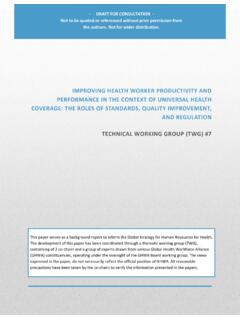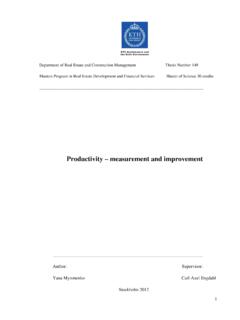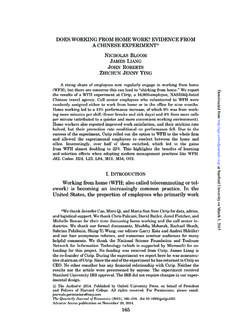Transcription of Productivity: Concepts, Measurement & Performance
1 `. RESEARCH PAPER productivity : Concepts, Measurement & Performance December 2016. Table of Contents Table of Contents FOREWORD IV. PRODUCT IVITY: CONCE P TS, Measurement A ND Performance V. 1 PRODUCT IVITY CONCE PT S 1. What is productiv ity? 1. Why doe s pr oductivity matter? 1. Determinants of pr oductiv ity grow th 3. 2 Measurement OF PRODU CTIVITY 4. Indica tor s 4. Coverage and units of Measurement 6. Limita tions of me asure ment 6. 3 QUEENSLAND PROD UCT IV ITY PER FORMANCE 8. MFP and labour pr oductivity 8. A global producti v ity challe nge 11. Industry labour pr oductivity growth 14. productivity and gr owth in incomes 16. productivity gaps and convergence 18. 4 POLICY AND PR OD UCTIVITY 24.
2 Policy fra mework 24. APPENDIX A : GROWTH ACCOUNTING 26. APPENDIX B : productivity AND COMPONENT INDICES 28. REFERENCES 29. Queensl and productivity Commission productivity : Concepts, Measurement and Performance ii The Role of the QPC. The Queensland productivity Commission provides independent advice on complex economic and regulatory issues, and proposes policy reforms, with the goal of increasing productivity , driving economic growth and improving living standards in Queensland. Wide-ranging, open and transparent public consultation underpin these functions. The Commission is an independent statutory body established under the Queensland productivity Commission Act 2015. The Commission's work encompasses four key streams: The Commission public inquiries into matters relating to productivity , economic operates on the development and industry in Queensland, as directed by the principles of Treasurer independence, rigour, advice and research on matters beyond a formal inquiry responsiveness, function transparency, equity, advice and guidance to departments, including providing efficiency and independent support and information on the quality of effectiveness.
3 Regulatory proposals investigation of competitive neutrality complaints about state and local government business activities. The Commission operates independently from the Queensland Government its views, findings and recommendations are based on its own analyses and judgments. The Commission has an advisory role. This means that it provides independent advice to the government that contributes to the policy development process but any policy action will ultimately be a matter for the government. Queensl and productivity Commission productivity : Concepts, Measurement and Performance iii Foreword Foreword Welcome to the first paper prepared as part of the Commission's research program.
4 One of the Commission's functions is to undertake research on matters that support the goal of increasing productivity , driving economic growth and improving living standards in Queensland. As the key driver of long-term growth in real per capita incomes, productivity growth is vital to improve our living standards. Given the importance of productivity growth and that we are named the Queensland productivity Commission, it seems natural that our first research paper discusses productivity . This paper is a primer' or introduction to measuring and interpreting productivity , and to some of the issues investigated in productivity studies. It summarises Queensland's productivity Performance and places that Performance in a national and international context.
5 There are many areas for further investigation including: industry productivity analysis and drivers of Performance productivity gaps, convergence and implications for Queensland businesses capital Measurement output Measurement in those industries with a high proportion of government service provision, such as education and health policy drivers of improved productivity Performance . Future research papers will look at these and similar issues. The Commission's inquiries also provide an opportunity to examine Queensland's productivity Performance in detail with, for example, the Commission's current inquiry into manufacturing in Queensland taking a closer look at manufacturing productivity Performance and its drivers.
6 The core data used to construct state-level productivity estimates is released by the Australian Bureau of Statistics at the end of each year. The 2016 release will include experimental estimates of Net Capital Stocks by industry, by state, which should further our understanding of industry productivity Performance in Queensland. Our intention is to publish an annual update discussing Queensland's productivity Performance . We would welcome your feedback on this publication. Kim Wood Principal Commissioner Queensl and productivity Commission productivity : Concepts, Measurement and Performance iv productivity : Concepts, Measurement and Performance productivity : Concepts, Measurement and Performance Key Points productivity is, put simply, how efficiently inputs are used to produce outputs in the economy.
7 productivity growth is important as it is a major determinant of the growth in living standards. Between 1985 86 and 2014 15, Queensland's multifactor productivity (MFP) grew annually by per cent on average, compared with per cent in the rest of Australia. From a peak in 2007 08, MFP in Queensland declined until 2010 11, with some subsequent recovery. For the rest of Australia, after a significant period of declining to stagnant growth, from 2010 11 improved MFP Performance has returned MFP to the 2003 04 level. Internationally, many countries have recorded poor productivity Performance over the last decade. The decline in MFP in Queensland over the last decade can, in large part, be explained by extended periods of drought, large investments in water and electricity infrastructure, large investments in mining, and in particular, the unprecedented level of capital investment associated with the LNG.
8 Industry, and a decline in the quality of mining resources. Ultimately, productivity improvements at the economy-wide level will depend upon the actions of individual enterprises. The government can best support productivity growth by ensuring the overall policy framework: promotes competition enables firms to respond quickly to market forces facilitates research and development enhances human capital ensures the availability of key economic infrastructure maintains stable institutions. Queensl and productivity Commission productivity : Concepts, Measurement and Performance v productivity Concepts 1 productivity Concepts What is productivity ? productivity is a commonly used term, but is often not well understood.
9 It can mean different things to different people for example, financial professionals may view productivity through a prism of revenue, costs and profit, whereas engineers consider productivity from a technical perspective, such as in terms of the operational capacity of plant and equipment. In economics, productivity relates to the transformation of inputs into outputs. It is a measure of how efficiently resources are used in that transformation process, and is expressed in terms of the amount of output produced per unit of input consumed. productivity is sometimes referred to as productive efficiency (Box 1).1. In this context, productivity can be defined as: the efficiency with which an entity such as a firm or industry, or at the aggregate level an economy, is using its resources (labour, materials and capital) in the production process to generate output in the form of goods and services.
10 productivity is a relative concept and should not be confused with production. productivity growth, or an improvement in productivity , implies that either: more output is produced with the same amount of inputs, or less inputs are required to produce the same level of output. Accordingly, increased production does not necessarily result in productivity growth: productivity is about working smarter , rather than working harder .2. Why does productivity matter? productivity growth is the major determinant of long-term growth in living standards. As Paul Krugman famously noted: productivity isn't everything, but in the long run, it is almost everything. A country's ability to improve its standard of living over time depends almost entirely on its ability to raise output per At an economy-wide level, productivity growth generates greater returns on total inputs and provides more income that can be made available for distribution to owners of those inputs.






